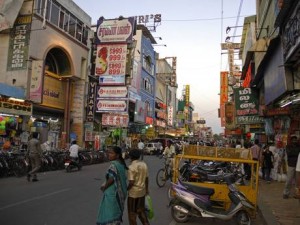L’Independent è andato a vedere come sta Pondicherry, la città indiana con un passato francese che fa da scenario di base per “La vita di Pi”. Ecco il reportage (a chi interessa)
Pondicherry: A corner of India that is forever France
Will the glimpse of this gracious town revealed in ‘Life of Pi’ survive the subcontinent’s booming economy? Mark Jones finds out
SUNDAY 13 JANUARY 2013
I’d been driving for three days in Tamil Nadu: from Madurai in the south to Thanjavur (formerly Tanjore), before heading north to Chennai. Every Indian village and rural town along the way was its own mini-Manhattan: people everywhere, horns blaring, permanent rush hour. Everything was colour, activity, pollution and decay. My senses needed a rest. I was looking forward to Pondicherry.
If you’ve seen the Ang Lee film Life of Pi you’ll understand why. The opening scenes are set in the Pondicherry of the hero’s early life. Whether you’re watching in 3D or not, the lush gardens, European mansions and elegant walkways leap out of the screen. This is a film, and a pretty fantastical one at that. All the same, Ang Lee’s vision could have been lifted straight from the guidebooks and tourist literature. Pondicherry is “The Indian Côte d’Azur” and “The Riviera of the East”, a haven of French style and refinement separated from Boomtown India.
My wife had travelled throughout the country in 2000, and after the chaos and stress of Varanasi, Rajasthan and the rest, found refuge in a small guesthouse on the Pondicherry seafront. Everyone was on bicycles, or they strolled along the tree-lined boulevards. It was as if an elegant French country town had been transported to the Bay of Bengal.
Which is more or less what happened. By 1850, the British had secured their grip on India. They allowed the retreating French to remain in four small pockets of South Indian territory. Pondicherry was pocket central. The British were content to let this Gallic anomaly survive until it, too, gained its full independence in 1963.
The French laid out their streets in a formal grid pattern. This was White Town. Over the canal, or Drain, the Tamil quarter, Black Town, grew up in its own organic way – albeit with a great number of fine mansions built by wealthy traders.
It was in one such mansion that I spent my first night. Maison Perumal is a small hotel that’s painstakingly recreated the cool courtyards and covered walkways of the Tamil style. I was soon to learn that this was a good architectural deed in an otherwise naughty world.
In 2006, Pondicherry became Puducherry – having reverted to its pre-colonial Tamil name. It was no longer an anomaly. This was indeed boomtown India. Pondi – as its long-term residents like to call it – is already swollen. As in so many Indian cities, the economic miracle has had its way, spawning a population increase of over 20 per cent in the past two censuses. In 2013, if it hasn’t done so already, the population will reach a million. That landmark may not be celebrated by the authorities. It certainly won’t be by the residents, who are increasingly het up about the threat to their slower, more refined way of life.
After I settled in at the Maison Perumal, my driver took me over to Hotel de l’Orient, a beautifully restored French quarter hotel. There I had dinner with an English resident, Michael Weston. A musician who recorded with Steve Winwood, among others, Michael now runs a project called Dance Routes with his wife, a classical Indian dancer.
He is building a new home out of town. And he’s worried about Pondi. “The pressure on the cultural heritage is immense,” he told me. “Although there are national bodies in place, implementation is always the bogeyman. If not for enlightened individuals such as Ajit, I very much doubt that what little is left here would have a chance of surviving.”
It was obvious I needed to meet Ajit. I rang him and arranged a meeting for the following morning. First, we talked more about the pressures on this special and unique place. For an area with such a history, the people governing and rebuilding the town are relentlessly short-termist: knock down that crumbling mansion, put a shiny new building in its place. There are dozens of beautifully preserved houses and streets, especially in the French quarter. But there are also as many crumbling shells.
And what does every self-respecting boomtown need? An airport. Pondicherry’s is due to open in February. When those planes arrive from Bangalore and beyond, the business class seats will be full of more speculators ready to wheel and deal in the town’s real estate market.
I won’t go into the tangled politics of Tamil Nadu and the Pondicherry city authority. All you need to know is that those beautiful colonial buildings of “white town” and the classic Tamil villas of “black town” are not seriously protected. Some 700 listed heritage buildings have been lost in the past decade, according to the conservation body Intach, the Indian National Trust for Art and Cultural Heritage.
Ajit Koujalgi runs the local branch of Intach. His office is housed in a classic Tamil mansion in a quiet side street off the bustling Mahatma Gandhi thoroughfare. The cool, shaded courtyard doubles as an exhibition of Pondi heritage – and an eloquent plea in words, pictures, plans and drawings for this remarkable city to be looked after properly.
“Pondicherry is fast losing its special physical character and atmosphere,” says Intach’s mission statement, “not just because of the increasing population, traffic and pollution, but also due to the alarming loss of old buildings in the name of development.”
Ajit, bearded, in grey T-shirt and jeans, is an architect and an Aurovillian. Auroville is an experimental city, located a few miles out of town, that grew out of the Sri Aurobindo ashram that dominates social and educational life in Pondi. Its “citizens” opt out of conventional society but remain very actively involved in its problems and challenges.
That’s certainly true of Ajit. Auroville is something of an architect’s dream and has long attracted idealistic designers eager to experiment with materials and technologies. But though Ajit lives there still, 15 years ago he had an epiphany. “I thought, ‘There are too many architects in Auroville. I’m needed in Pondicherry!'” So he committed himself to conservation – and rebuilding.
“You can’t stop the destruction,” he says. “But maybe you can talk them into building something decent.” He calls it “façade intervention”. If you can’t save the building, at least preserve the look. Take 5 Rue Perumal Kovil, once a mildewed, rotting Tamil mansion. The owner’s suggested new design looked like the cross section of a Costa Brava hotel. Thanks to Ajit and his team, the final building is an elegant, classical, grey 18th-century house.
In the same street, Intach worked with the Indian hotel group CGH Earth to open first Maison Perumal and now the Palais de Mahe in the French quarter. This is another façade intervention: a fine three-storey hotel with walkways, porticos and a very welcome, if not especially authentic, swimming pool.
When he walks around Pondicherry today, Ajit admits that he winces more often than he smiles. “But what can you do but carry on fighting?” It’s thanks to people like him that the town does still live up to the prose of the tour company brochures … and that the Pondicherry of Life of Pi is not a 3D reimagining of a place that no longer exists.
As I walked out of the Palais de Mahe the next morning, the streets of the French quarter are, almost, as tranquil and shaded as I’d been told they would be. From the cathedral of Notre Dame des Anges, angelic voices are indeed drifting on the sea breezes. The interior, all duck-egg-blue walls and bright tangerine pillars, is a lovely meeting of South Indian gaiety with European loftiness.
But the spiritual heart of Pondi is the ashram of Sri Aurobindo founded by the eponymous mystic and his enigmatic follower, the Mother, in 1926. You see the ashram’s distinctive light-grey buildings all around town: schools, libraries, shops and restaurants. The main building is a silent, contemplative grove, where Aurobindo and the Mother are laid to rest.
Walking back to the seafront I saw two significant signs. The first, on the streets where the ashram stands, was a horn with a red line through it. “Good luck,” I thought as a couple of scooters and a truck beeped and barged their way past. The second, on the beach itself, was a large banner with the words “If you litter Pondicherry will not be the same”.
Well, Pondi is not the same: not the same as British India, not the same as those bursting, cacophonous cities and depressingly litter-strewn villages of the South Indian countryside. It remains a wonderful and unique place to visit. Some things have changed for the better in 10 years. There are some wonderful hotels, an eclectic range of restaurants; chic and quirky boutiques have popped up.
So 2013 is going to be a grande année for the Tamil/French city of Puducherry/Pondicherry. Even with the inevitable delays, the airport will be up and running by the time it celebrates the 40th anniversary of its establishment as a city-state on 1 July and tourist numbers will swell further. Let’s hope they will be able to go on seeing the Pondicherry of shaded streets, elegant mansions and whispering parkland without having to put on 3D glasses.
Travel essentials
Getting there
Mark Jones travelled with Greaves Travel (020-7487 9111;greavesindia.co.uk), which has a seven-night tour in Tamil Nadu from £1,399pp. The price includes BA flights from Heathrow, two nights at the ITC Grand Chola in Chennai and four nights’ B&B at Maison Perumal, Pondicherry, transfers, sightseeing and guides. British Airways (0844 493 0787; ba.com) flies non-stop from Heathrow to Chennai; returns start at £458.
Staying there
Maison Perumal and Palais de Mahe are run by CGH Earth (cghearth.com). Doubles start at Rs5,500 (£62) and Rs8,500 (£96) respectively, B&B. Hotel de L’Orient, Pondicherry (00 91 413 234 3067; hotel-de-lorient.neemranahotels.com). B&B from Rs4,000 (£45). Villa Shanti, Pondicherry (00 91 413 420 0028; lavillashanti.com). B&B from Rs7,000 (£79). Le Dupleix, Pondicherry (00 91 413 2226 001; sarovarhotels.com). B&B from Rs7,500 (£85). Dune Hotel, Pondicherry (00 91 413 324 4040;thedunehotel.com). B&B from Rs6,050 (£68).
Visiting there
Intach (00 91 413 222 5991; intachpondicherry.org), offers Pondicherry Heritage Trail maps. Auroville is open from 9am to 5.30pm (auroville.org). There are also guesthouses (00 91 413 262 2704;aurovilleguesthouses.org).


